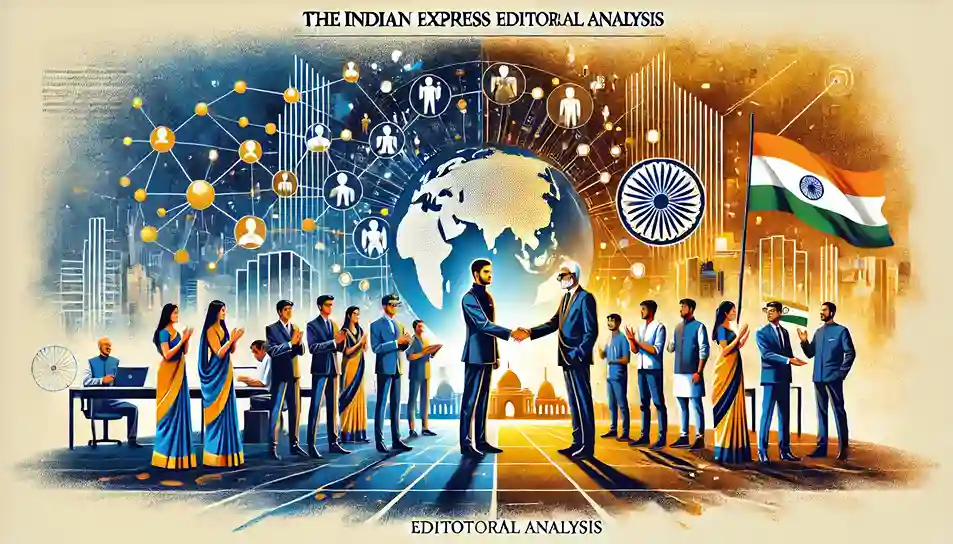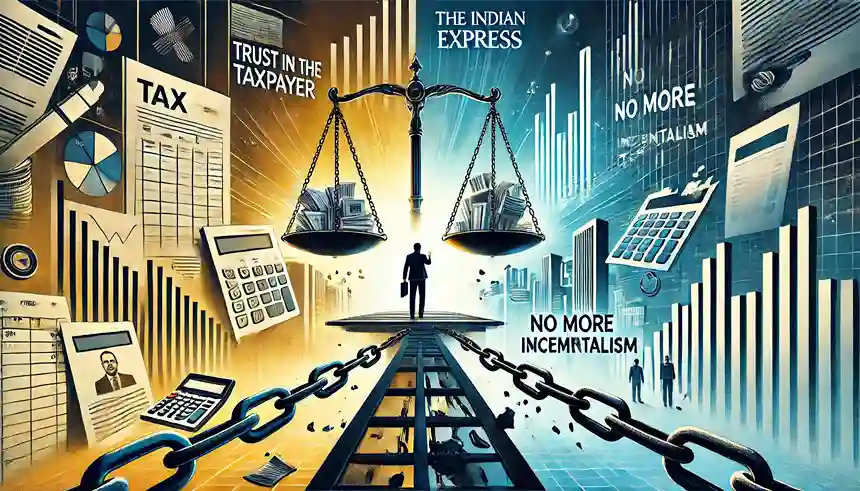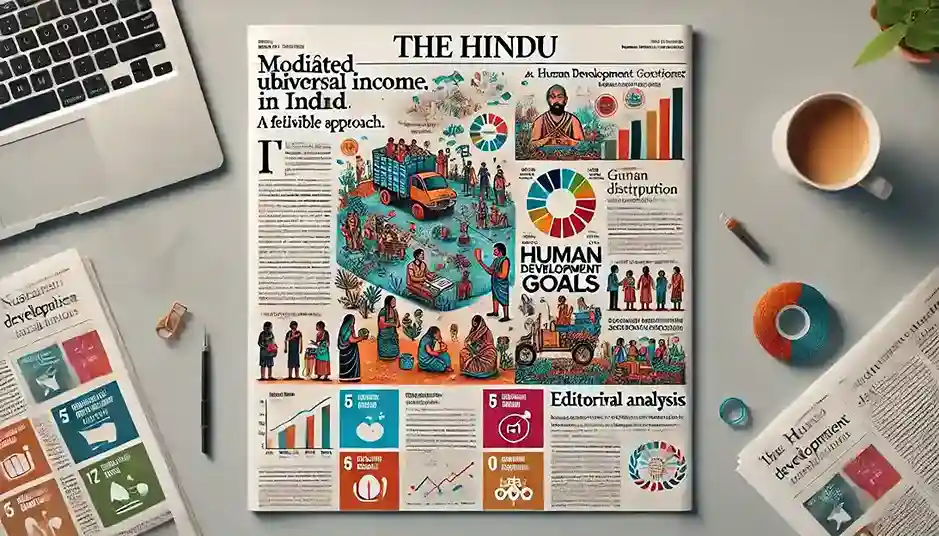Analysis of The Hindu Editorial 1: A modified UBI policy may be more feasible
Context
The discussion around Universal Basic Income (UBI) has garnered attention worldwide due to the rising concerns over unemployment, driven by technological advances such as automation and artificial intelligence. In countries like India, where youth unemployment and jobless growth have exacerbated income inequality, UBI has emerged as a potential solution to provide a social safety net. However, the primary challenge remains its financial feasibility. A more practical approach may involve implementing a modified version of UBI, supplemented by other transfer policies as necessary.
Introduction: The UBI Debate
Universal Basic Income (UBI) has resurfaced as a policy proposal in response to global employment challenges. The International Labour Organization’s report highlights the slow pace of job creation despite rising productivity due to automation. In India, youth unemployment is a significant concern, and jobless growth is contributing to widening income disparities. This trend has reignited discussions around UBI as a way to ensure economic security for all citizens, especially in times of social and economic upheaval.
The Case for UBI in India
A few years ago, UBI became a hot topic in India, with discussions revolving around whether it could replace some inefficient welfare schemes with direct income transfers. The idea gained traction after the 2016-17 Economic Survey of India recommended UBI as a policy worth considering. Technological advancements in the JAM (Jan-Dhan, Aadhaar, Mobile) infrastructure further made the implementation of Direct Benefit Transfers (DBTs) more feasible. This brought UBI back into the spotlight as a potential solution to India’s growing social and economic challenges.
- Analysis of The Indian Express Editorial – February 13, 2025

- Analysis of The Indian Express Editorial – February 12, 2025

- Analysis of The Indian Express Editorial – December 31, 2024

- Analysis of The Indian Express Editorial – December 19, 2024

- Analysis of The Indian Express Editorial – December 18, 2024

Should India Adopt a Modified UBI?
The central question remains: Should India implement a version of UBI to tackle issues like unemployment and poverty? The debate centers on the feasibility and desirability of such a policy. While a UBI may be desirable as a social safety net, budgetary constraints make its full implementation challenging. Critics argue that India should focus on boosting employment or increasing mass consumption demand. However, these critiques miss the point. A UBI isn’t designed to solve every problem but to provide a safety net for those affected by unemployment. Like any policy, UBI should be evaluated based on its ability to address specific issues.
Comparing UBI with Other Social Safety Nets
UBI differs from existing safety net policies, which often target specific demographics or depend on certain criteria. These include:
- Targeted Policies: Programs aimed at specific groups, such as women, farmers, or the elderly.
- In-kind Benefits: Schemes like the Public Distribution System (PDS) that provide goods instead of cash.
- Conditional Programs: Policies like the Mahatma Gandhi National Rural Employment Guarantee Scheme (MGNREGS) that require participants to work, or mid-day meal schemes tied to school attendance.
A key advantage of UBI is that it eliminates the need for complex eligibility criteria, potentially reducing errors and inefficiencies in the system.
Budgetary Considerations
When designing social safety nets, budget constraints play a crucial role in determining the best approach. Policymakers must balance multiple objectives, such as providing minimum consumption support, alleviating long-term poverty, or helping vulnerable groups. For example, in remote rural areas, in-kind transfers may be more effective due to logistical challenges. However, targeted programs often suffer from exclusion errors and bureaucratic delays, limiting their effectiveness.
Current State-Level Schemes
India has already experimented with direct income transfer schemes in the agricultural sector.
- Rythu Bandhu Scheme (RBS): This program in Telangana provided farmers with unconditional payments of ₹4,000 per acre.
- KALIA (Krushak Assistance for Livelihood and Income Augmentation): Odisha replicated this approach, providing income support to small farmers.
- PM-KISAN: Launched at the national level, this scheme offered ₹6,000 per year to small and marginal farmers. By 2020-21, it covered around 10 crore households, at a cost of ₹75,000 crore, or 0.4% of India’s GDP.
Challenges of Current Schemes
Despite their success, these schemes have faced challenges such as inclusion and exclusion errors, largely due to issues like Aadhaar verification failures and banking infrastructure problems. These limitations have fueled calls for a more universal approach, which could simplify implementation and reduce errors.
The Advantages of Universal Income Transfers
Universal income transfers offer several benefits. They minimize administrative costs by eliminating the need for targeting, reduce the risk of exclusion errors, and lower the potential for corruption by involving fewer intermediaries. Additionally, universal transfers avoid the disincentives to work that are often associated with targeted welfare programs.
Common Objections to UBI
A frequent criticism of UBI is that it would provide financial support to the wealthy as well as the poor. However, this objection overlooks how tax and welfare systems typically function. In advanced economies, individuals pay taxes and receive government benefits based on their circumstances. Ultimately, the net impact on their income matters. Wealthier individuals would likely contribute more in taxes than they receive from UBI, making the system equitable overall.
A Feasible UBI Proposal
The major obstacle to implementing UBI in India is its financial cost. Some proposals suggest transfers as high as 3.5% to 11% of GDP, which would necessitate drastic cuts to other welfare programs or significant tax hikes. A more realistic approach would involve a limited universal income transfer scheme pegged at 1% of GDP per capita. This would provide every citizen with approximately ₹144 per month, or ₹500 per household—an amount comparable to PM-KISAN.
This scheme could be implemented by doubling the PM-KISAN budget and making it universal. This would extend benefits not just to farmers but also to landless laborers, who are often poorer. While the transfer amount may seem small, it is in line with the Tendulkar poverty line of around ₹1,600 per month.
Implementation Challenges
For UBI to succeed, several logistical issues need to be addressed. These include ensuring access to cash-out points, minimizing biometric authentication failures, and resolving electronic payment system glitches. Overcoming these last-mile delivery challenges is crucial for the success of a universal income transfer system.
Conclusion: A Balanced Approach
In light of India’s fiscal constraints, it is natural to be skeptical of new policies when similar ones already exist. However, a modified UBI scheme could serve as a base, to which other policies—such as targeted transfers for women—could be added over time. For example, MGNREGS provides employment but may exclude vulnerable groups like the elderly or disabled. Combining MGNREGS with a modified UBI could ensure comprehensive coverage. The COVID-19 pandemic demonstrated the value of both income and in-kind transfers. In this context, UBI could provide crucial financial support during crises, while other programs address specific needs.
- [PDF] Kiran SSC 10600+ General Awareness Book English
![[PDF] Kiran SSC General Awareness Book English](https://savepdf.in/wp-content/uploads/2024/12/PDF-Kiran-SSC-10600-General-Awareness-Book-English-1156x650.webp)
- [PDF] – Manorama Yearbook 2025: A Comprehensive Guide to Knowledge and Exam Success

- [PDF] Blackbook 25000+ GA English Medium
![[PDF] Blackbook 25000+ GA English Medium](https://savepdf.in/wp-content/uploads/2024/11/PDF-Blackbook-25000-GA-English-Medium-1156x650.webp)
- [PDF] Reasoning Made Easy – Download Now
![[PDF] Reasoning Made Easy](https://savepdf.in/wp-content/uploads/2024/11/Reasoning-Made-Easy-1156x650.webp)
- [PDF] Police Recruitment Challenger – Download Now
![[PDF] Police Recruitment Challenger](https://savepdf.in/wp-content/uploads/2024/11/Police-Recruitment-Challenger-1156x650.webp)
Analysis of The Hindu Editorial 2: India’s India’s SDG focus and its human development issues
Context
For any country striving towards sustainable development, boosting human development is crucial. Without addressing issues related to education, health, gender equality, and income disparity, sustainable development remains an elusive goal. India, like many nations, faces significant challenges in aligning its human development initiatives with the Sustainable Development Goals (SDGs).
Introduction
In 2023, New Delhi hosted the G-20 Summit, which committed to accelerating the implementation of the UN Agenda 2030 for Sustainable Development. Shortly after, the United Nations held an SDG Summit to review the progress of the 17 Sustainable Development Goals (SDGs). These global gatherings underscore the critical importance of sustainability, with a clear link between human development and achieving these goals. Nobel laureate Amartya Sen’s perspective on development, famously outlined in his book Development as Freedom, echoes this connection. According to Sen, true development expands people’s real freedoms, which is at the core of human development.
The Essence of Human Development
Human development is about expanding people’s capabilities to live the life they value. This concept covers several key areas:
- Freedom from hunger and poor health
- Gender and income equality
- Access to quality education
Together, these elements not only drive human development but also lay the foundation for sustainable development. Countries that wish to move forward on the path of sustainability must prioritize these aspects.
Development and the SDGs
The Human Development Index (HDI), developed by the United Nations Development Programme (UNDP), tracks a country’s performance across three major dimensions:
- Life expectancy (long and healthy life)
- Educational attainment (expected years and mean years of schooling)
- Income per capita (a decent standard of living)
Each of these dimensions aligns with key Sustainable Development Goals:
- SDG 3: Good Health and Well-being
- SDG 4: Quality Education
- SDG 5: Gender Equality
- SDG 8: Decent Work and Economic Growth
- SDG 10: Reduced Inequalities
For countries like India, achieving sustainable development means focusing on these areas to uplift the quality of life for its citizens.
India’s Human Development Ranking (HDR 2023-24)
According to the latest Human Development Report (HDR) for 2023-24, India falls into the ‘medium human development’ category with an HDI value of 0.644, ranking 134th out of 193 countries. Although India has seen progress, moving from an HDI of 0.638 in 2019-20 to 0.644 in 2022, the pace of improvement has been slower than in some neighboring countries. For instance:
- Malaysia ranks 63rd
- Thailand 66th
- China 75th
- Bangladesh 129th
India’s growth in human development, while notable, has not been as rapid as in countries like Bangladesh and Bhutan, which improved their HDI rankings by 12 and 10 places, respectively, between 2015 and 2022.
- [PDF] “Arihant Computer Awareness Book 1” – Free Download
![[PDF] Arihant Computer Book.pdf” – Free Download for Competitive Exams](https://savepdf.in/wp-content/uploads/2025/04/PDF-Arihant-Computer-Book.pdf-–-Free-Download-for-Competitive-Exams-1040x650.webp)
- [PDF] The Pragmatic Programmer by David Thomas and Andrew Hunt

- [PDF] Structure and Interpretation of Computer Programs
![[PDF] Structure and Interpretation of Computer Programs](https://savepdf.in/wp-content/uploads/2024/12/PDF-Structure-and-Interpretation-of-Computer-Programs-1157x650.webp)
- [PDF] Computer Fundamentals by Anita Goel – Free Download
![[PDF] Computer Fundamentals by Anita Goel – Free Download](https://savepdf.in/wp-content/uploads/2024/11/Computer-FundameComputer-Fundamentals-by-Anita-GoelComputer-Fundamentals-by-Anita-Goelntals-by-Anita-Goel-1156x650.png)
- [PDF] – Mainframe Systems Programming: An Introduction – Download Now
![Mainframe Systems Programming: An Introduction – [PDF]](https://savepdf.in/wp-content/uploads/2024/10/PDF-–-Mainframe-Systems_20241004_162243_0000-1156x650.webp)
Human Development in India (1990-2022)
India’s HDI has grown by 48.4% over the last three decades, rising from 0.434 in 1990 to 0.644 in 2022. However, between 2015 and 2022, India only improved its ranking by four positions. One significant reason for this sluggish growth is the impact of the COVID-19 pandemic, which hit critical dimensions of human development, particularly education and income.
Gender Disparities in India
Another challenge for India in achieving the SDGs is the glaring gender gap. The Gender Development Index (GDI), a component of the HDR, measures human development disparities between men and women. Countries in the ‘medium human development’ category, including India, exhibit noticeable gender inequality.
- India has one of the largest Labour Force Participation Rate (LFPR) gaps, with a 47.8% point difference between men (76.1%) and women (28.3%).
- Female labor participation in India remains low, especially when compared to neighboring countries like China (53.6%) and Bangladesh (39.2%).
- According to the Periodic Labour Force Survey (PLFS) 2022-23, 37% of working-age women (15 years and above) were in the labor force, an improvement from 23.3% in 2017-18. Yet, significant rural-urban disparities persist:
- Rural female participation jumped from 24.6% in 2017-18 to 41.5% in 2022-23.
- Urban participation showed only marginal growth, increasing from 20.4% to 25.4% during the same period.
These gender disparities, particularly in the workforce, require deeper analysis and policy interventions to ensure more inclusive development.
Income Inequality in India
In addition to gender disparities, income inequality in India is a significant obstacle to sustainable development. According to the HDR, the share of income held by the top 1% in India is 21.7%, which is higher than:
- Bangladesh (11.6%)
- China (15.7%)
- Bhutan (18.1%)
- Nepal (9.7%)
India’s income inequality is not only higher than the South Asia average of 19.6% but also exceeds the global average of 17.5%. This growing wealth concentration undermines efforts to reduce poverty and inequality, making it crucial for India to address these imbalances if it wants to meet the SDG targets.
Gender Development and Labour Force Participation Rate (LFPR) Gap: A Comparative Table
| Country | Female LFPR (%) | Male LFPR (%) | LFPR Gender Gap (%) |
|---|---|---|---|
| India | 28.3 | 76.1 | 47.8 |
| China | 53.6 | 74.7 | 21.1 |
| Bangladesh | 39.2 | 82.6 | 43.4 |
| Bhutan | 53.5 | 72.2 | 18.7 |
This table highlights the significant gender gap in labor force participation, with India having the highest disparity among the compared nations. Addressing this gap will be critical to improving gender equality and overall human development.
Conclusion: Addressing Income and Gender Inequality
India faces two major human development challenges: the gender gap and income inequality. The concentration of wealth in the hands of a small elite and the persistent underrepresentation of women in the workforce are hindering progress toward achieving the SDGs. With a focus on reducing these inequalities, India can improve its human development outcomes and move closer to the sustainable development targets set by the UN.

